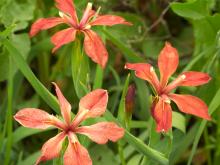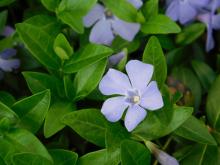Wildflowers, Grasses and Other Nonwoody Plants
Media

Species Types
Scientific Name
Barbarea vulgaris
Description
Yellow rocket is a mustard native to Eurasia that was introduced long ago and today is found across North America. The mustard family used to be called the Cruciferae, because of the cross shape formed by the four petals.
Media

Species Types
Scientific Name
Packera glabella (formerly Senecio glabellus)
Description
Butterweed, one of Missouri’s seven species of ragworts or groundsels, is the only one that is an annual. It grows in colonies, at times covering acres of floodplain. Stems are heavily ridged and usually inflated or hollow. It blooms April–June.
Media

Species Types
Scientific Name
Phlox divaricata
Description
A common, eye-catching native spring wildflower common in woodlands, blue phlox occurs nearly statewide.
Media

Species Types
Scientific Name
Phlox paniculata
Description
Perennial phlox has big, showy clusters of flowers. A tall, late-blooming native wildflower of woodland borders, steamsides, and gravel bars, it is also an old-fashioned garden favorite.
Media

Species Types
Scientific Name
Phlox pilosa
Description
Downy phlox, also called prairie phlox, is a perennial wildflower with lance-shaped leaves and showy, rounded clusters of pink or lavender flowers. It is similar to blue phlox, but it grows more often in prairies and other open, sunny, and drier habitats.
Media

Species Types
Scientific Name
Festuca arundinacea
Description
You’ve seen it a million times, now learn to identify it! Technically an exotic invasive plant, tall fescue is practically everywhere, from lawns to levees, and from pastures to (unfortunately!) prairies.
Media

Species Types
Scientific Name
Iris virginica
Description
Ten species of iris grow wild in our state, but only four of them are native. Of our native irises, this one is the most common. But drainage “improvements” are eliminating the habitat of this beautiful wetland wildflower.
Media

Species Types
Scientific Name
Iris fulva
Description
This attractive, copper-colored iris is gaining in popularity as a garden plant even though its numbers are declining in the wild. Like many other native plants, copper iris is hardy, low-maintenance, and has few pest or disease problems.
Media

Species Types
Scientific Name
Vinca minor
Description
Common periwinkle is a low-growing, mat-forming, purple-flowering perennial that is woody at the base. Native to Eurasia, it is often grown as a groundcover. It has proven invasive in much of the eastern United States and frequently escapes from cultivation. Planting it is not recommended.
Media

Species Types
Scientific Name
Subfamily Asclepiadoideae
Description
Milkweeds are a group of plants that used to have their very own family. Now part of the dogbane family, they’re still a pretty distinctive group.
See Also
About Wildflowers, Grasses and Other Nonwoody Plants in Missouri
A very simple way of thinking about the green world is to divide the vascular plants into two groups: woody and nonwoody (or herbaceous). But this is an artificial division; many plant families include some species that are woody and some that are not. The diversity of nonwoody vascular plants is staggering! Think of all the ferns, grasses, sedges, lilies, peas, sunflowers, nightshades, milkweeds, mustards, mints, and mallows — weeds and wildflowers — and many more!





















